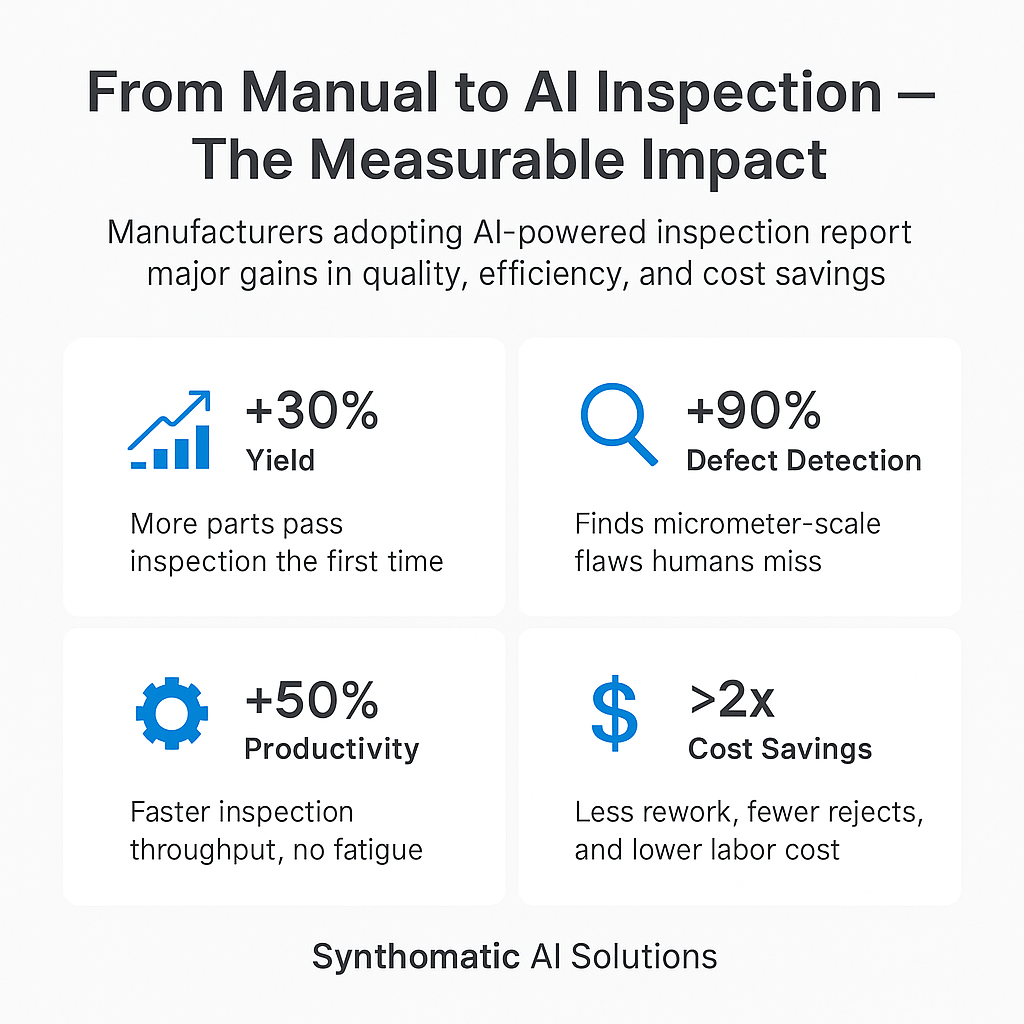AI in Manufacturing: Why Now Is the Time for Businesses of All Sizes to Embrace It

From Manual to AI Inspection - The Measurable Impact
October 2025
Artificial Intelligence (AI) is no longer an expensive technology reserved for large corporations with deep pockets. Thanks to recent advancements in AI and deep learning, even small and mid-sized manufacturers can now access equally powerful tools that improve quality, increase productivity, and reduce operational costs, especially in visual inspection.
AI Investment and Adoption in Manufacturing is Surging
The numbers tell a compelling story. AI investment in the manufacturing sector is projected to grow from $5.94 billion in 2024 to $8.57 billion in 2025, representing a staggering growth rate of 44.2% (AllAboutAI.com). Recent studies show that 70% of manufacturers have already adopted some form
of AI technology in their processes (Forbes.com) and Gartner forecasts that by 2025, over 50% of manufacturing companies will have integrated AI into their quality control processes. (Koerber-digital.com).
Source: World Economic Forum and AllAboutAI.com
Historically, advanced AI inspection systems required costly custom integration, dedicated engineering teams, and significant computing resources – making them inaccessible to smaller manufacturers. But today:
- Deep learning models are trained faster and more efficiently using transfer learning and cloud-based resources.
- Edge computing enables real-time visual analysis on affordable hardware.
- Off-the-shelf AI frameworks and platforms reduce the barrier to entry for system deployment.
These changes have lowered both the development and deployment cost of AI systems. At Synthomatic AI Solutions, we are leveraging these advancements to offer affordable, turnkey visual inspection systems designed specifically for small to medium-sized manufacturers.
Benefits of AI Visual Inspection
Improved Yield and Product Quality
AI excels at detecting micrometer-sized defects that traditional systems or even trained human eyes often miss. This translates directly into better yield and fewer defective parts:
- Up to 30% improvement in manufacturing yield with AI-powered quality control systems. (PostIndustria.com)
- Up 90% increase in defect detection rates according to McKinsey with AI-based visual inspection and quality control. (Corebts.com) (Corebts.com)
Among manufacturers using AI, 39% apply it to quality inspection—more than any other area.
Source: PostIndustria.com
AI systems do not tire, lose focus, or vary in performance and they solve many of the problems inherent in manual inspection. Human inspectors are inconsistent – defect detection rates vary between 60% and 90% due to fatigue and other factors. Manual inspection is also slow, often creating bottlenecks on fast-moving lines. It is expensive too: the average U.S. quality control inspector earns over $89,000 a year, with costs rising as production scales. And manual methods cannot deliver real-time insights, meaning defects often go undetected until it is too late. (AssemblyMag.com)
In contrast, AI inspection systems are fast, consistent, and scalable. They do not tire or miss defects, and they provide real-time feedback to catch problems early. This leads to faster throughput, better product quality, and significant cost savings, especially for manufacturers looking to scale efficiently.
- According to a study by McKinsey & Company, AI-powered quality inspection can increase productivity by up to 50%.
- A car seat manufacturer employed an AI-driven inspection system and experienced a 30% reduction in defect rates and a 30-fold reduction in costs when compared to manual inspection. (AssemblyMag.com)
|
|
Manual Inspection |
AI Inspection |
|
Inspection Speed |
Slow, sample based |
High-Speed, 100% inspection |
|
Accuracy & Consistency |
Results vary by operator |
Consistent, objective, µm size |
|
Labor Costs |
High, scales poorly |
Low, continuous operation |
|
Traceability |
Minimal, operator notes |
Every part digitally recorded |
|
Insight |
Minimal feedback |
Rich analytics, predictive QC |
While the advantages are compelling, AI is not a silver bullet. Here is a balanced look:
Concerns with AI Vision Inspection
|
Challenge |
Synthomatic’s Solution |
|
Upfront Setup Costs AI requires upfront investment in hardware, training, and integration |
Scalable and Affordable We offer industry-leading affordability that is deployed quickly to match your needs.
|
|
Change Management |
Seamless Integration
|
|
Data Dependency |
Expert Support |
Advantages of AI Vision Inspection
|
Advantage |
Synthomatic’s Solution |
|
Accuracy AI reduces false calls, adapts to complex surfaces and product variations.
|
Purpose-built Solutions AI models paired with industrial vision and lighting tuned for your application. |
|
Consistency |
High Accuracy AI models and optics developed for your specific application.
|
|
Productivity |
Robust Hardware and Reliability Reliable industrial automation and high-performance graphics processing.
|
|
Scalability
|
Automation Capable Designed for easy integration with your automation systems. |
|
Traceability |
Comprehensive Reporting Tools Keeps a secure record of defects, enabling continuous improvement |
Main Benefits of AI Powered Solutions – Surveyed Results
|
|
Improved Accuracy |
62% |
|
|
Ability to Automate Previously Manual Tasks |
48% |
|
|
Ability to Deal with Variations |
45% |
|
|
Cost Savings |
38% |
Source: A3 Association for Advancing Automation (A3 Assoc.)
The Bottom Line: AI is a Strategic Advantage, Not Just a Tech Trend
AI is not just about efficiency – it is about staying competitive in a market where quality expectations are rising, and margins are tight. The good news is, thanks to the democratization of AI technology, manufacturers of any size can now harness the power of AI. Whether you are producing aerospace components, medical devices, or precision-machined parts, integrating AI into your quality process is no longer out of reach – it is a practical step forward.
Want to Learn More or See a Free Demo?
Contact our team today to schedule a personalized demonstration of our AI quality control system.
